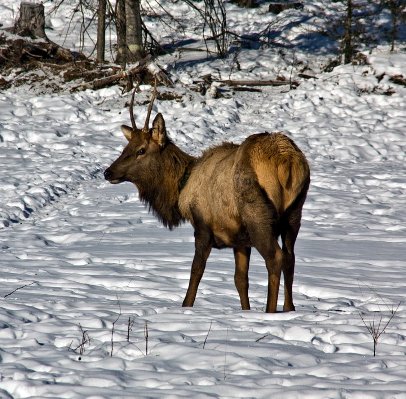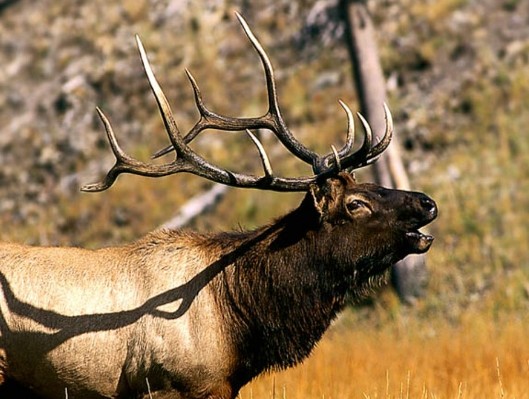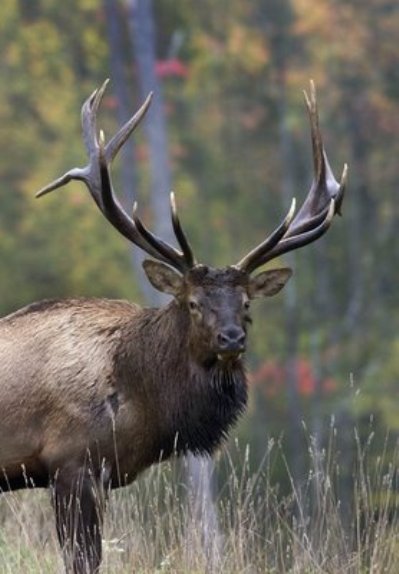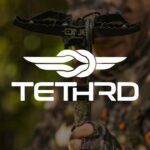LAST UPDATED: May 1st, 2015
The Rocky Mountain Elk Foundation (RMEF) wants to help ensure that this year’s elk hunter is better informed before releasing their next arrow, and frankly, so do we. Learn how to tell the difference between a 300 inch and a 375 inch bull – because knowing is half the battle.
The RMEF, with adapted material from the Boone and Crockett Club, offer the following list of general guidelines to help cure those itchy trigger fingers. We’ve added a few warranted photos to get you drooling.
A male elk’s first antlers are typically spikes.
Counting Points—Most mature bull elk are 6x6s. In good habitat, a bull may have a 5-point rack as a 2-1/2-year-old and then a small six-point rack as a 3-1/2-year-old. Its best antlers, however, usually come at age 9-1/2 to 12-1/2, so remember that not every 6×6 is a trophy. Instantly identifying a six-point bull is not difficult. The fourth point (the G-4), is sometimes called the dagger point, it is normally the longest point and most distinctive feature of an elk rack. If the main beam goes straight back from the dagger you’re almost certainly looking at a five-point antler. If there’s another point rising upward behind the dagger, perhaps making a horizontal “Y,” then you’re looking at a six-point antler and another point beyond that, perhaps a seven-point antler and so on.
Find the “dagger point” (G-4) and count the points behind it. This will give you a quick refererence to the true size and amount of points on the bull.
Just like a whitetail, the tip of the main beam is counted as a point, but not measured as one. Instead it is measured as part of the main beam.
Beam Length—This measurement will be about 25% of your bull’s final score. Most great elk have long main beams. In the all-time records book, the average beam length of the top 10 typical bulls is over 58 inches. However, the average beam length of the bottom 10 is 55-4/8 inches – not much difference. If a bull appears able to “scratch his rear-end with his antlers,” it likely has the frame to be a trophy. No need to spend much more time considering beam length.
Inside Spread—Inside spread will make up about 10% – 15% of a bull’s final score. Boone and Crockett records show a wide variation on spreads of trophy elk. Interestingly, the narrowest head in the book outscores the widest, which should be enough to tell you that spread isn’t everything. The top 10 typical entries range from 38-2/8 to 53 inches of inside spread for an average of 46-2/8 inches. The bottom 10 bulls range from 38 to 49-4/8 inches for an average of 42-4/8 inches – not a significant difference. In the field, simply look for a spread that stretches well outside the ears. This should indicate a spread somewhere in the low to mid-40s, and that’s really all you need be concerned about.
Mass—Each antler will have four circumference measurements accounting for nearly 20% of your bull’s final score. Most really big elk have heavy antlers that carry good mass through the length of the main beam. However, mass is very hard to judge. It’s unusual to have a lot of time to look at a big bull and mass is not where you should spend most of it. Just remember that very few elk considered “big” in the more visible characteristics have thin antlers. When hunting, quickly look for antlers that are visibly as large or larger in circumference than the ear bases, which are about 9 inches around. More importantly, the antlers should maintain that thickness to at least the fifth point.
The main beams of this bull elk show good mass, shown here by the comparison of its antler to ear circumference.
Tine Length—Tine Length will account for roughly 40% of the bull’s final score. If you have time to study a bull, really look at the tines. Length of the points is the single most important trophy criteria. The good news is that point length is one of the easiest things to judge because there is a yardstick sitting right there on the bull. On a big American elk, the distance from the burr of the antler to the tip of the nose is about 15-4/8 inches. Starting at the bottom of the antlers and working up, a curved brow tine that appears to reach the end of the nose will be about 18 inches long (this is a great start). The next two points are usually shorter, but they still need to approach the burr-to-nose yardstick. A good bull will have at least 16 inches on both of these points (G-2 and G-3).
The true mark of a trophy bull comes from the dagger point. It is usually the longest point, and on a monster bull it will be double (if not more) the burr to nose length. On a 6×6, the last point matters a lot. It has to be strong, at least 8 or 10 inches. This is less important if the bull is a 7×7, but you still need some inches in the top of the rack.
The Boone and Crockett Club requires a minimum of 360 inches for a typical American elk to enter the esteemed Awards Book, and an incredible 375 inches for any entry into the All-time Records Book. To make Pope and Young, your typical American elk needs 260 inches.
This fall after you’ve trekked deep into the western wilderness and called in a bull, eagerly waiting at full draw for just the right moment, remember what you just read. You can’t take an arrow back once it’s released. If you do manage to get one of these tall tined monsters in the back of your truck, drop us a line and show it off on our Facebook page. We’ll be the ones drooling over you for a change. Good luck!
About the Rocky Mountain Elk Foundation:
RMEF is leading an elk country initiative that has conserved or enhanced habitat on over 5.9 million acres—a land area equivalent to a swath three miles wide and stretching along the entire Continental Divide from Canada to Mexico. RMEF also works to open, secure and improve public access for hunting, fishing, and other recreation. Learn more by joining them online.








